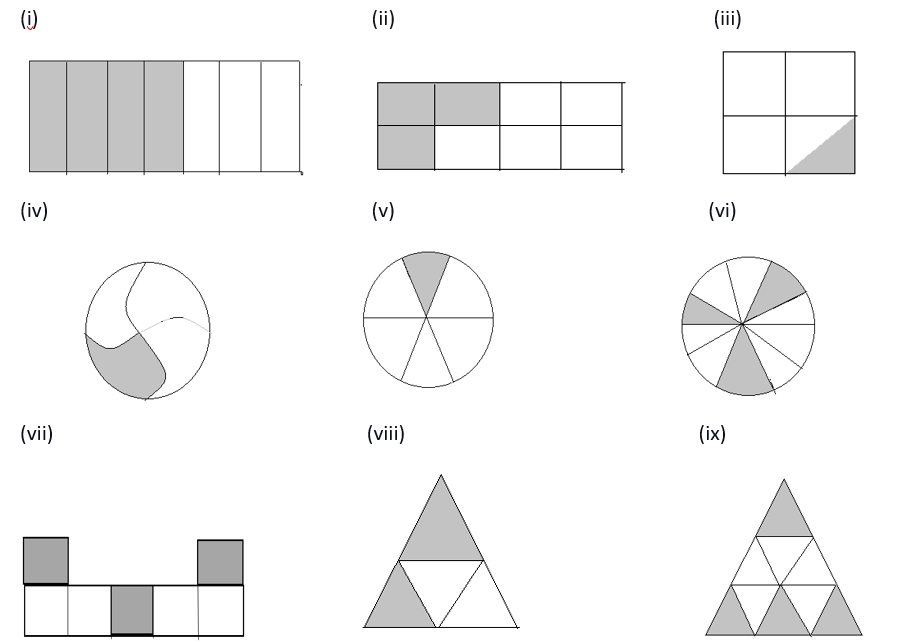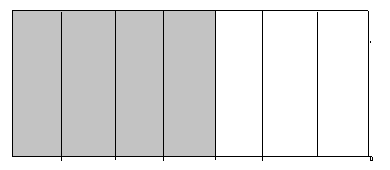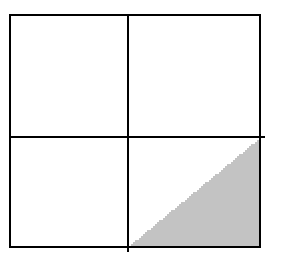
What is the fraction of each of the shaded parts?


Answer
510.6k+ views
Hint: We need to find the fraction of each of the shaded parts. We start to solve the question by finding out the number of shaded portions and the total number of portions of each figure. Then, the ratio of the number of shaded portions to the total number of portions to get the desired result.
Complete step-by-step solution:
We are given a few figures and are asked to find the fraction of each of the shaded parts. We will be solving the given question by finding out the ratio of the number of shaded portions to the total number of portions.
A fraction, in mathematics, represents a part of a whole thing. It consists of two parts namely,
numerator, denominator.
The number on the top is called the numerator.
The number on the bottom is called the denominator.
Let us understand the concept of the fraction with an example as follows,
Example:
$\Rightarrow \dfrac{a}{b}$
In the above fraction,
$a$ is the numerator of the fraction
$b$ is the denominator of the fraction
According to the question,
We need to find the fraction of each of the shaded parts.
(i)

In the above figure,
The total number of portions is equal to 7.
The number of shaded portions is equal to 4.
The fraction of each of the shaded parts is given as follows,
$\Rightarrow \dfrac{\text{number of shaded portions}}{\text{total number of portions}}$
Substituting the values, we get,
$\Rightarrow \dfrac{4}{7}$
(ii)

In the above figure,
The total number of portions is equal to 8.
The number of shaded portions is equal to 3.
The fraction of each of the shaded parts is given as follows,
$\Rightarrow \dfrac{\text{number of shaded portions}}{\text{total number of portions}}$
Substituting the values, we get,
$\Rightarrow \dfrac{3}{8}$
(iii)

In the above figure,
The total number of triangles formed in the above figure is 8. So, the total number of portions is equal to 8.
The number of shaded portions is equal to 1.
The fraction of each of the shaded parts is given as follows,
$\Rightarrow \dfrac{\text{number of shaded portions}}{\text{total number of portions}}$
Substituting the values, we get,
$\Rightarrow \dfrac{1}{8}$
(iv)

In the above figure,
The total number of portions is equal to 4.
The number of shaded portions is equal to 1.
The fraction of each of the shaded parts is given as follows,
$\Rightarrow \dfrac{\text{number of shaded portions}}{\text{total number of portions}}$
Substituting the values, we get,
$\Rightarrow \dfrac{1}{4}$
(v)

In the above figure,
The total number of portions is equal to 6.
The number of shaded portions is equal to 1.
The fraction of each of the shaded parts is given as follows,
$\Rightarrow \dfrac{\text{number of shaded portions}}{\text{total number of portions}}$
Substituting the values, we get,
$\Rightarrow \dfrac{1}{6}$
(vi)

In the above figure,
The total number of portions is equal to 10.
The number of shaded portions is equal to 3.
The fraction of each of the shaded parts is given as follows,
$\Rightarrow \dfrac{\text{number of shaded portions}}{\text{total number of portions}}$
Substituting the values, we get,
$\Rightarrow \dfrac{3}{10}$
(vii)

In the above figure,
The total number of portions is equal to 7.
The number of shaded portions is equal to 3.
The fraction of each of the shaded parts is given as follows,
$\Rightarrow \dfrac{\text{number of shaded portions}}{\text{total number of portions}}$
Substituting the values, we get,
$\Rightarrow \dfrac{3}{7}$
(viii)

In the above figure,
The total number of portions is equal to 4.
The number of shaded portions is equal to 2.
The fraction of each of the shaded parts is given as follows,
$\Rightarrow \dfrac{\text{number of shaded portions}}{\text{total number of portions}}$
Substituting the values, we get,
$\Rightarrow \dfrac{2}{4}$
(ix)

In the above figure,
The total number of portions is equal to 9.
The number of shaded portions is equal to 4.
The fraction of each of the shaded parts is given as follows,
$\Rightarrow \dfrac{\text{number of shaded portions}}{\text{total number of portions}}$
Substituting the values, we get,
$\Rightarrow \dfrac{4}{9}$
Note: The given question is a direct formula based and any mistake in writing the formula to find the fraction of each shaded part will result in an incorrect solution. We must be careful while counting the total number of portions and the number of shaded portions in the figure to get precise results.
Complete step-by-step solution:
We are given a few figures and are asked to find the fraction of each of the shaded parts. We will be solving the given question by finding out the ratio of the number of shaded portions to the total number of portions.
A fraction, in mathematics, represents a part of a whole thing. It consists of two parts namely,
numerator, denominator.
The number on the top is called the numerator.
The number on the bottom is called the denominator.
Let us understand the concept of the fraction with an example as follows,
Example:
$\Rightarrow \dfrac{a}{b}$
In the above fraction,
$a$ is the numerator of the fraction
$b$ is the denominator of the fraction
According to the question,
We need to find the fraction of each of the shaded parts.
(i)

In the above figure,
The total number of portions is equal to 7.
The number of shaded portions is equal to 4.
The fraction of each of the shaded parts is given as follows,
$\Rightarrow \dfrac{\text{number of shaded portions}}{\text{total number of portions}}$
Substituting the values, we get,
$\Rightarrow \dfrac{4}{7}$
(ii)

In the above figure,
The total number of portions is equal to 8.
The number of shaded portions is equal to 3.
The fraction of each of the shaded parts is given as follows,
$\Rightarrow \dfrac{\text{number of shaded portions}}{\text{total number of portions}}$
Substituting the values, we get,
$\Rightarrow \dfrac{3}{8}$
(iii)

In the above figure,
The total number of triangles formed in the above figure is 8. So, the total number of portions is equal to 8.
The number of shaded portions is equal to 1.
The fraction of each of the shaded parts is given as follows,
$\Rightarrow \dfrac{\text{number of shaded portions}}{\text{total number of portions}}$
Substituting the values, we get,
$\Rightarrow \dfrac{1}{8}$
(iv)

In the above figure,
The total number of portions is equal to 4.
The number of shaded portions is equal to 1.
The fraction of each of the shaded parts is given as follows,
$\Rightarrow \dfrac{\text{number of shaded portions}}{\text{total number of portions}}$
Substituting the values, we get,
$\Rightarrow \dfrac{1}{4}$
(v)

In the above figure,
The total number of portions is equal to 6.
The number of shaded portions is equal to 1.
The fraction of each of the shaded parts is given as follows,
$\Rightarrow \dfrac{\text{number of shaded portions}}{\text{total number of portions}}$
Substituting the values, we get,
$\Rightarrow \dfrac{1}{6}$
(vi)

In the above figure,
The total number of portions is equal to 10.
The number of shaded portions is equal to 3.
The fraction of each of the shaded parts is given as follows,
$\Rightarrow \dfrac{\text{number of shaded portions}}{\text{total number of portions}}$
Substituting the values, we get,
$\Rightarrow \dfrac{3}{10}$
(vii)

In the above figure,
The total number of portions is equal to 7.
The number of shaded portions is equal to 3.
The fraction of each of the shaded parts is given as follows,
$\Rightarrow \dfrac{\text{number of shaded portions}}{\text{total number of portions}}$
Substituting the values, we get,
$\Rightarrow \dfrac{3}{7}$
(viii)

In the above figure,
The total number of portions is equal to 4.
The number of shaded portions is equal to 2.
The fraction of each of the shaded parts is given as follows,
$\Rightarrow \dfrac{\text{number of shaded portions}}{\text{total number of portions}}$
Substituting the values, we get,
$\Rightarrow \dfrac{2}{4}$
(ix)

In the above figure,
The total number of portions is equal to 9.
The number of shaded portions is equal to 4.
The fraction of each of the shaded parts is given as follows,
$\Rightarrow \dfrac{\text{number of shaded portions}}{\text{total number of portions}}$
Substituting the values, we get,
$\Rightarrow \dfrac{4}{9}$
Note: The given question is a direct formula based and any mistake in writing the formula to find the fraction of each shaded part will result in an incorrect solution. We must be careful while counting the total number of portions and the number of shaded portions in the figure to get precise results.
Recently Updated Pages
You are awaiting your class 10th results Meanwhile class 7 english CBSE

The number of solutions in x in 02pi for which sqrt class 12 maths CBSE

Write any two methods of preparation of phenol Give class 12 chemistry CBSE

Differentiate between action potential and resting class 12 biology CBSE

Two plane mirrors arranged at right angles to each class 12 physics CBSE

Which of the following molecules is are chiral A I class 12 chemistry CBSE

Trending doubts
Convert 200 Million dollars in rupees class 7 maths CBSE

Bluebaby syndrome is caused by A Cadmium pollution class 7 biology CBSE

What are the controls affecting the climate of Ind class 7 social science CBSE

Write a letter to the editor of the national daily class 7 english CBSE

AIM To prepare stained temporary mount of onion peel class 7 biology CBSE

Differentiate between weather and climate How do they class 7 social science CBSE





